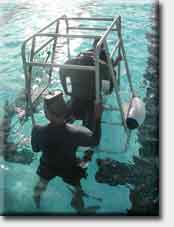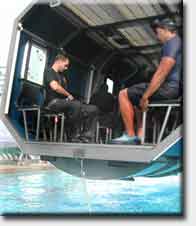|
About JPAC
Home
Command Overview
Leadership
History
Operations
Detachments
Missions
Gulf War
Cold War
Vietnam War
Korean War
World War II
Repatriations
Public Affairs
Press Releases
JPAC in the News
Photo Gallery
Links
Employment
Military Assignment
Contact

Laboratory
Dog Tags
Mitochondrial DNA
OdontoSearch
Museum Partners
Click
here for the JPAC
Command Video
Click here to read the script from
the JPAC Command Video
|
JPAC TEAM PREPARE FOR DIFFICULT MISSIONS WITH SURVIVAL TRAINING
By Staff Sgt. Erika Gladhill, JPAC PAO
|
|
| A JPAC photographer prepares to be dunked during the water egress training. Photo by SSG Erika Gladhill, JPAC PAO |
Places in the world accessible only by aircraft hold clues to the military’s missing, and recent training will help the Joint POW/MIA Accounting Command get there safely.
JPAC teams, based at Hickam Air Force Base, Hawaii , completed a three-day aircraft crash and water survival course this week. More teams are scheduled to attend the course.
Soldiers, Sailors, Airmen, Marines and Department of the Navy civilians make up the teams. Their mission is to search for, recover and identify remains of Americans missing from the Persian Gulf War, the Vietnam War, the Cold War, the Korean War and World War II. Their duty brings them around the world.
“As much as we are in helicopters – about 85 percent of the trips – you can never tell when you may crash,” said JPAC team leader and U.S. Air Force Capt. Chris Tarrant. “It’s made them [the service members] more prepared as far as flying in helicopters and [conducting] helicopter operations. They now have a baseline knowledge about what to do if a helicopter crashes.”
Instructors from Survival Systems USA, Inc. trained JPAC teams in a 16-hour course concentrating on aircraft ditching and egress techniques, employing Emergency Underwater Breathing devices, and Surface water survival.
Instructors launch the course first with four hours of classroom and then four hours of hands-on training.
|
 |
JPAC teams first practice escape tactics in a floating seat, known as a Shallow Water Egress Trainer, while turned upside down in water.
Once students are comfortable with escape procedures and underwater breathing techniques, they move onto the Modular Amphibious Escape Training System [MAETS™] training. T he MAETS™ is custom-built, made to represent a CH-46, CH-53 and AAV ditching sequence. The base product, the Modular Escape Training System [METS], can be configured to replicate any aircraft or vehicle desired. |
| JPAC teams practice escape tactics in a floating seat, known as a Shallow Water Egress Trainer, while turned upside down in water. Photo by SSG Erika Gladhill, JPAC PAO |
The US Marine Corps MAETS™ is suspended from a metal beam that stretches across a pool at the Marine Corps Base Kaneohe Bay, Hawaii.
It’s built as close to aircraft specifications as possible allowing students to practice evaluating a crash and executing an escape.
JPAC members sit inside the aircraft-like model, wait for it to fall and become submerged in the water below. JPAC members gripped their seats in hopes of maintaining their position underwater.
U.S. Army Sgt. 1 st Class Kenneth Slankard, a JPAC team member and a noncommissioned officer in-charge, trained with rafts, chain formations, casualty rescue and long-term ‘raft survival.’
After learning water survival techniques, Slankard said the most challenging experience was learning to overcome the fear of drowning.
“I had a difficult time not allowing water through my nose and I was choking,” Slankard said. “It was very scary.”
He added, “I’ll never get in a helicopter until I understand everything that I have to do to get out of the helicopter, and my team won’t either.”
The training, he said, considerably mitigates the safety risks for deploying troops. |
 |
U.S. Army Sgt. Jennifer Sweet, JPAC mortuary affairs specialist, said the training strengthened each person’s weakness. Her weakness was feeling claustrophobic, she said.
“You are sitting out there in the water, almost as though you are at a dunking booth. Then with a sudden flip, you are stuck in a seat and you have to feel your way out … and it has to be fast.”
JPAC team member and forensic anthropologist, Dr. Jay Silverstein, agreed that the training was demanding.
“There’s a real sense of panic but you have to remain calm,” he said. |
| Joint POW MIA Accounting Command teams, based at Hickam Air Force Base, Hawaii, endured water egress training this week. Teams learned to breath and escape from an aircraft crash over water. Photo by SSG Erika Gladhill, JPAC PAO |
Silverstein said, instructors taught that maintaining a sense of orientation can be lifesaving. By maintaining the position in a seat, one can maintain a frame of reference, regain a sense of orientation and move toward the exit.
Training for the worst-case scenario is part of a JPAC goal to be mission-ready.
Silverstein said that he appreciated the military infrastructure supporting the mission through training.
“To be a part of something like this is a real honor and a privilege,” Silverstein said.
The service members’ walk away with more than training skills, according to Sweet, JPAC members gained camaraderie.
“We’ll survive together,” Sweet said, “and we will not leave anybody behind.”
"Until they are home…"
Click on any photo for a larger image. Click the "Back" button to return to this page. |
| |
|
|
JPAC's
Commitment

The Americans shown above have been identified
and returned to their families over the past 30 years.
JPAC continues to fulfill the promise
to the families and those Americans waiting to come home.
JPAC Headlines
JPAC Team Tackles Tibet
JPAC Soldier receives Bronze Star
JPAC memorial dedicated
to those lost keeping the promise
The Greatest Tribute
|
